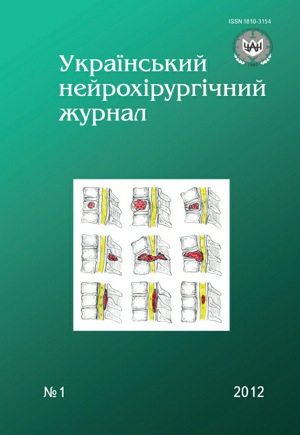Clinical and neurophysiological characteristics of patients with neurogenic intermittent claudication at the lumbar level spinal stenosis
DOI:
https://doi.org/10.25305/unj.57750Keywords:
lumbar stenosis, neurogenic intermittent claudication, diagnosis, transcranial magnetic stimulation, motor evoked potentialsAbstract
Purpose. The purpose of the study is to investigate the possibility of objectifying the nature and degree of spinal radicular structures and lumbar spinal cord dysfunction by using MEP-ENMG indicators.
Materials. Preoperative results of 30 patients with neurogenic intermittent claudication in lumbar stenosis (LS) were analyzed.
Results. MEP performance most significantly changed in patients who failed to cover a distance of 500 m (14 patients), those with bilateral symptoms (12), those with severity on the VAS scale for numbness of more than 8 points (12). Dependence of the indicators and the duration of disease was not established. After the walking tests 11 patients showed changes in NPh indicators: increase in (P<0.05) minimum latentсy of F-waves, increase in chronodyspersy ; increase in MEP and CCMT latentcy.
Conclusions. Probable changes were determined in NPh indicators of functional condition of radicular and spinal structures, which to some extent reflect the severity of lumbar stenosis and which may be useful for substantiating the prognosis and tactics of treatment of such patients. The use of MEP-ENMG methods can improve diagnosis of the degree of dysfunction of peripheral and spinal structures in LS patients at the preoperative stage.
References
1. Yakhno NN, Shtuman DR, editors. Bolezni nervnoy sistemy: rukovodstvo dlya vrachey: v 2 tomakh [Diseases of the nervous system: guidelines for physicians. In 2 volumes]. Moscow: Meditsina; 2003;1. Russian.
2. Prodan AI, Perepechay OA, Podlipintsev VV [et al.]. Kontseptualnaya model peremezhayushcheysya neyrogennoy khromoty i tranzitornoy radikulopatii pri poyasnichnom spinalnom stenoze [Conceptual model of neurogenic intermittent claudication, and transient at the lumbar radiculopathy spinal stenosis]. Litopys travmatologii ta ortopedii. 2008(1-2):218-25. Russian.
3. Nikitin SS, Kurenkov AL. Magnitnaya stimulyatsiya v diagnostike i lechenii bolezney nervnoy sistemy: rukovodstvo dlya vrachey [Magnetic stimulation in the diagnosis and treatment of diseases of the nervous system: guidelines for physicians]. Moscow: SASHKO; 2003. Russian.
4. Adamova B, Vohanka S, Dusek L. Dynamic electrophysiological examination in patients with lumbar spinal stenosis: is it useful in clinical practice? Eur Spine J. 2005 Apr;14(3):269-76. [CrossRef] [PubMed]
5. Bal S, Celiker R, Palaoglu S, Cila A. F-wave studies of neurogenic intermittent claudication in lumbar spinal stenosis. Am J Phys Med Rehabil. 2006 Feb;85(2):135-40. [CrossRef] [PubMed]
6. Plastaras CT, Joshi AB. The electrodiagnostic evaluation of radiculopathy. Phys Med Rehabil Clin N Am. 2011 Feb;22(1):59-74. [CrossRef] [PubMed]
7. Tsao B. The electrodiagnosis of cervical and lumbosacral radiculopathy. Neurol Clin. 2007 May;25(2):473-94. [CrossRef] [PubMed]
8. Di Lazzaro V, Pilato F, Oliviero A, Saturno E, Dileone M, Tonali PA. Role of motor evoked potentials in diagnosis of cauda equina and lumbosacral cord lesions. Neurology. 2004 Dec 28;63(12):2266-71. [CrossRef] [PubMed]
9. Lang E, Hilz MJ, Erxleben H, Ernst M, Neundörfer B, Liebig K. Reversible prolongation of motor conduction time after transcranial magnetic brain stimulation after neurogenic claudication in spinal stenosis. Spine (Phila Pa 1976). 2002 Oct 15;27(20):2284-90. [CrossRef] [PubMed]
10. Beyaz EA, Akyüz G, Us O. The role of somatosensory evoked potentials in the diagnosis of lumbosacral radiculopathies. Electromyogr Clin Neurophysiol. 2009 May-Jun;49(4):131-42. [PubMed]
11. Baramki HG, Steffen T, Schondorf R, Aebi M. Motor conduction alterations in patients with lumbar spinal stenosis following the onset of neurogenic claudication. Eur Spine J. 1999;8(5):411-6. [CrossRef] [PubMed]
12. Liu X, Konno S, Miyamoto M, Gembun Y, Horiguchi G, Ito H. Clinical value of motor evoked potentials with transcranial magnetic stimulation in the assessment of lumbar spinal stenosis. Int Orthop. 2009 Aug;33(4):1069-74. [CrossRef] [PubMed]
13. Senocak O, Hürel DM, Sener U, Uğurel B, Oztura I, Ertekin C. Motor conduction time along the cauda equina in patients with lumbar spinal stenosis. Spine (Phila Pa 1976). 2009 Jun 1;34(13):1410-4. [CrossRef] [PubMed]
14. Yamazaki K, Yoshida S, Ito T, Toba T, Kato S, Shimamura T. Postoperative outcome of lumbar spinal canal stenosis after fenestration: correlation with changes in intradural and extradural tube on magnetic resonance imaging. J Orthop Surg (Hong Kong). 2002 Dec;10(2):136-43. [PubMed]
15. Krasylenko OP, Pedachenko YuYe. Likuvannya syndromu neyrohennoyi intermituyuchoyi kulhavosti, obumovlenoho stenozom poperekovoho viddilu khrebtovoho kanalu [Treatment of neurogenic intermittent claudication syndrome caused by stenosis of the lumbar spinal canal]. Mizhnarodny Nevrologichny Zhurnal. 2011;3(41):21-6. Ukrainian.
16. Haig AJ, Geisser ME, Tong HC, Yamakawa KS, Quint DJ, Hoff JT, Chiodo A, Miner JA, Phalke VV. Electromyographic and magnetic resonance imaging to predict lumbar stenosis, low-back pain, and no back symptoms. J Bone Joint Surg Am. 2007 Feb;89(2):358-66. [PubMed]
17. Sandoval AE. Electrodiagnostics for low back pain. Phys Med Rehabil Clin N Am. 2010 Nov;21(4):767-76. [CrossRef] [PubMed]
Downloads
Published
How to Cite
Issue
Section
License
Copyright (c) 2012 Lidiya Chebotariova, Albina Tretiakova, Yuriy Pedachenko, Elena Krasilenko

This work is licensed under a Creative Commons Attribution 4.0 International License.
Ukrainian Neurosurgical Journal abides by the CREATIVE COMMONS copyright rights and permissions for open access journals.
Authors, who are published in this Journal, agree to the following conditions:
1. The authors reserve the right to authorship of the work and pass the first publication right of this work to the Journal under the terms of Creative Commons Attribution License, which allows others to freely distribute the published research with the obligatory reference to the authors of the original work and the first publication of the work in this Journal.
2. The authors have the right to conclude separate supplement agreements that relate to non-exclusive work distribution in the form of which it has been published by the Journal (for example, to upload the work to the online storage of the Journal or publish it as part of a monograph), provided that the reference to the first publication of the work in this Journal is included.









